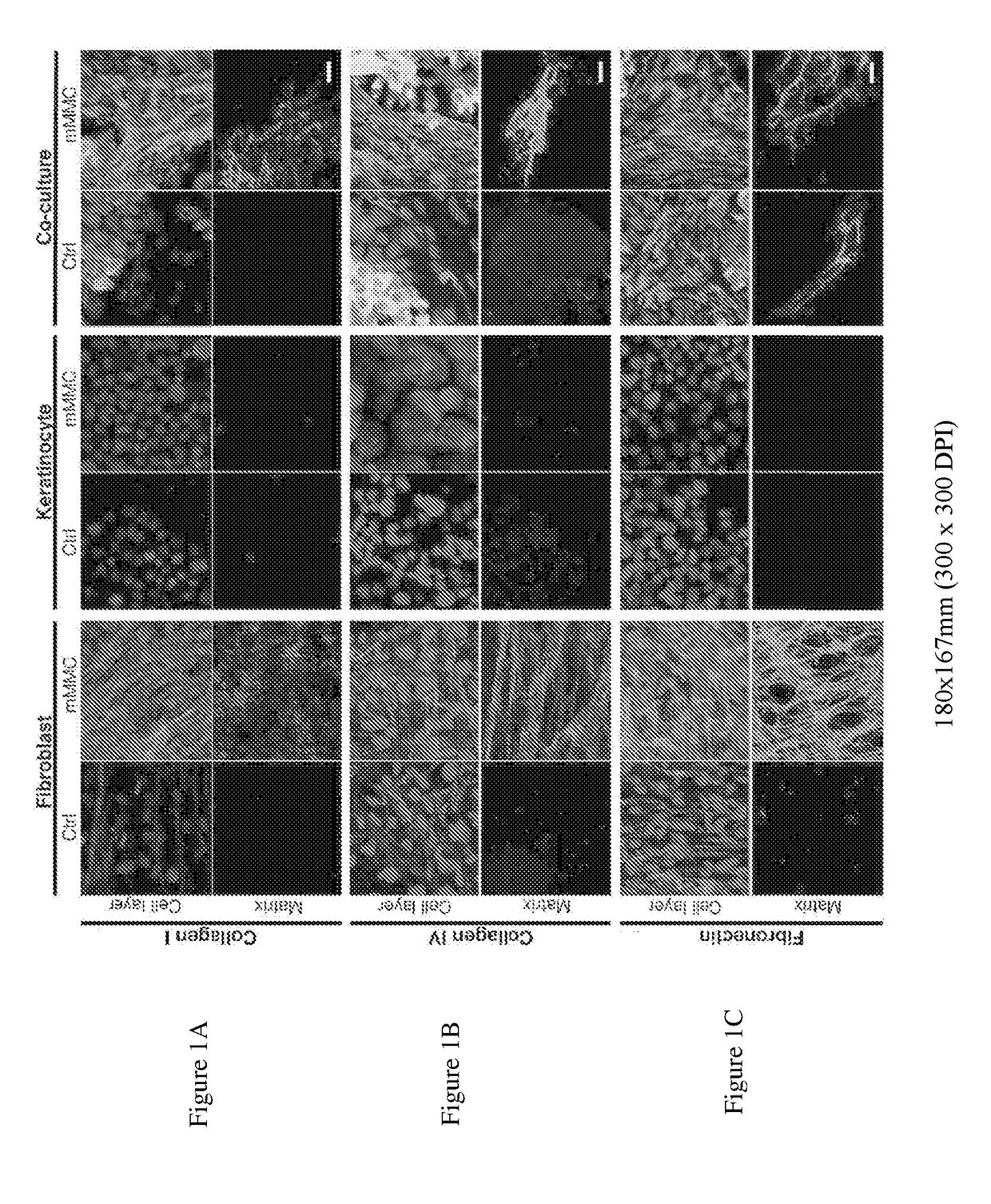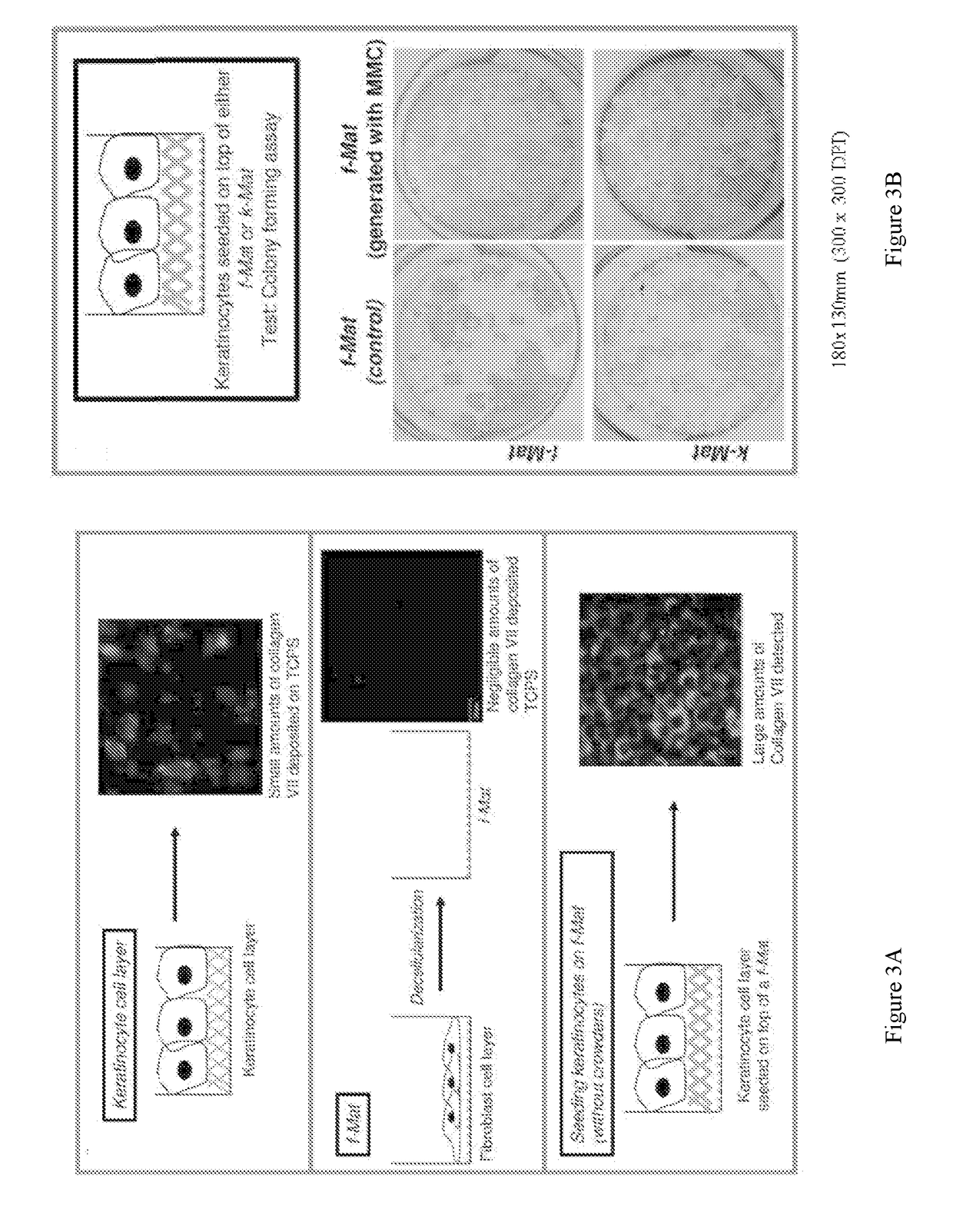Methods Of Producing Tissue-Mimetic Constructs And Uses Thereof
a tissue-mimetic and construct technology, applied in the direction of artificial cell constructs, skeletal/connective tissue cells, prostheses, etc., can solve the problems of poor ecm formation, dystrophic epidermolysis bullosa, and tissue fragility disorders
- Summary
- Abstract
- Description
- Claims
- Application Information
AI Technical Summary
Benefits of technology
Problems solved by technology
Method used
Image
Examples
example 1
[0143]Skin is one of the most accessible tissues for experimental biomedical sciences, and cultured skin cells represent one of the longest-running clinical applications of stem cell therapy. However, culture generated skin-mimetic multicellular structures are still limited in their application by the time taken to develop these constructs in vitro and by their incomplete differentiation. The development of a functional dermal-epidermal junction (DEJ) is one of the most sought after aspects of cultured skin, and one of the hardest to recreate in vitro. At the DEJ, dermal fibroblasts and epidermal keratinocytes interact to form an interlinked basement membrane of extracellular matrix (ECM), which forms as a concerted action of both keratinocytes and fibroblasts. Successful formation of this basement membrane is essential for “take” and stability of cultured skin autografts.
[0144]Interactive matrix production by mono- and co-cultures of primary human keratinocytes and fibroblasts was ...
example 2
[0174]Acellular matrices that are rich in extracellular matrix (“enriched ECM” or “eECM”) have potential for use as scaffolds for secondary cell seeding, for example of embryonic stem cells. However, current cell culture techniques for generating such matrices yield a fragile layer of eECM on the culture surface, which is challenging to handle and / or transfer for biomedical applications. Accordingly, there is a need to develop new methods for the production of eECM that would make a more robust eECM.
[0175]An agarose-eECM gel was developed, which could be customized to fit different wounds to improve skin wound healing. Agarose was chosen as the preferred gel for a number of reasons. For example, agarose is readily available, inexpensive and non-xenogeneic. Nonetheless, agarose had been an unexplored option as a scaffolding material for use in skin wound healing. As gel stiffness may affect cell adhesion and proliferation, it was important to optimize a working concentration of agaro...
example 3
[0176]Decellularized ECMs derived from different cell types were charcaterized by FESEM (field emission scanning electron microscopy) analysis, which provides an ultrastructural view of the cell-derived matrices. The cell-derived matrices were prepared from fibroblasts (f-Mat), keratinocytes (k-Mat) or a co-culture of fibroblasts and keratinocytes (co-Mat), as follows:
[0177]f-Mat: extracellular matrix obtained from decellularizing a fibroblast cell layer which have been cultured with macromolecular crowders;
[0178]k-Mat: extracellular matrix obtained from decellularizing a keratinocyte cell layer which have been cultured with macromolecular crowders;
[0179]co-Mat: extracellular matrix obtained from decellularizing a co-culture of fibroblasts and keratinocytes, which have been cultured with macromolecular crowders.
[0180]co-Mat matrices had the most fibrillar structure, resembling that of human dermal collagen (FIG. 13C). K-mat matrices had the least amount of fibrillar structure (FIG. ...
PUM
| Property | Measurement | Unit |
|---|---|---|
| Nanoscale particle size | aaaaa | aaaaa |
| Nanoscale particle size | aaaaa | aaaaa |
Abstract
Description
Claims
Application Information
 Login to View More
Login to View More - R&D
- Intellectual Property
- Life Sciences
- Materials
- Tech Scout
- Unparalleled Data Quality
- Higher Quality Content
- 60% Fewer Hallucinations
Browse by: Latest US Patents, China's latest patents, Technical Efficacy Thesaurus, Application Domain, Technology Topic, Popular Technical Reports.
© 2025 PatSnap. All rights reserved.Legal|Privacy policy|Modern Slavery Act Transparency Statement|Sitemap|About US| Contact US: help@patsnap.com



